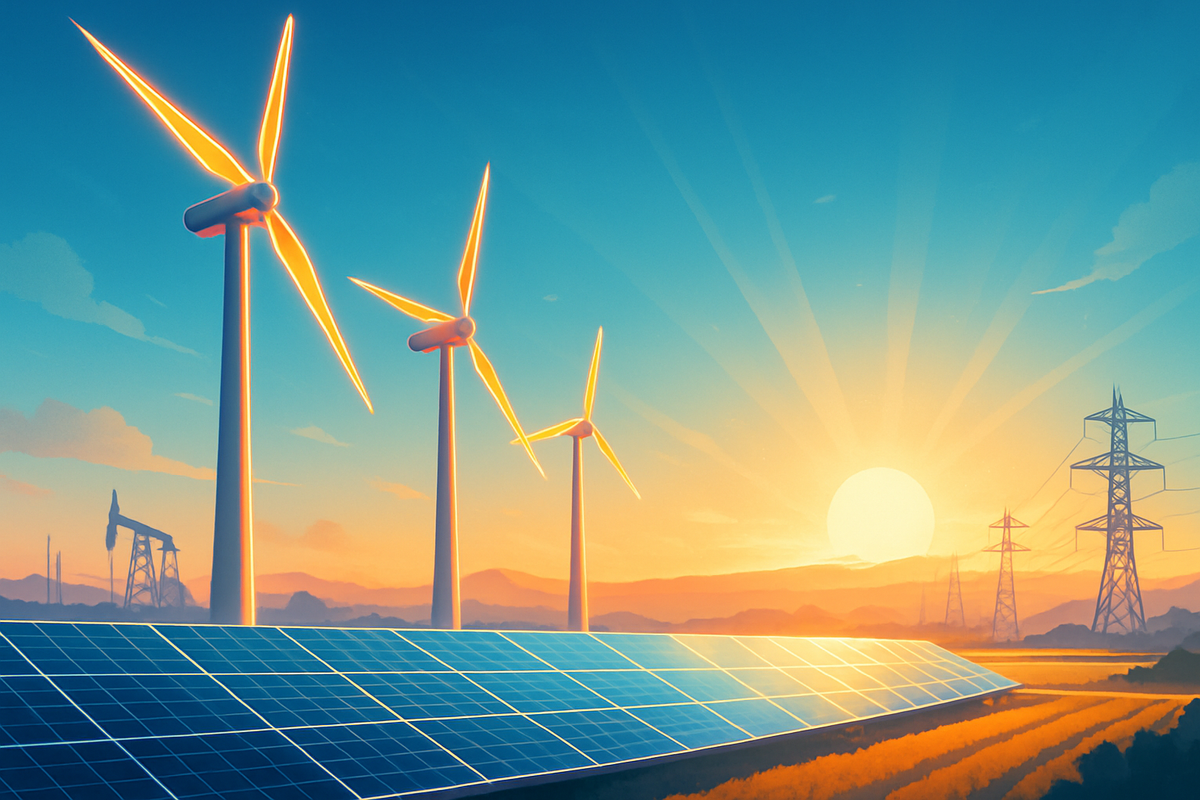
The financial markets are witnessing a significant resurgence in renewable energy stocks, marking a pivotal shift in investment sentiment and energy market dynamics. As of late 2025, clean energy companies are attracting substantial capital inflows, driven by a powerful combination of escalating global electricity demand, robust governmental policy support, and continuous technological breakthroughs. This renewed interest signals a profound transition in the energy landscape, with immediate implications for both burgeoning green industries and traditional commodity markets like oil and natural gas. Investors are increasingly reallocating capital, recognizing the long-term growth potential and strategic importance of sustainable energy solutions in an increasingly electrified world.
This resurgence is not merely a cyclical uptick but reflects a deeper, structural transformation. The imperative for energy security, coupled with ambitious climate targets, has propelled renewable energy to the forefront of national agendas. The market is moving beyond a subsidy-driven model to one where fundamental demand and cost competitiveness are the primary drivers. This shift is reshaping investment strategies, fostering innovation, and setting the stage for a prolonged period of growth for companies positioned at the vanguard of the clean energy revolution, while simultaneously challenging the established dominance of fossil fuel producers.
The Perfect Storm: Policy, Demand, and Innovation Fueling Clean Energy's Rise
The renewed vigor in renewable energy stocks is underpinned by a confluence of powerful forces. Governments worldwide are enacting and strengthening policies that provide unprecedented support for the energy transition. Landmark legislation such as the U.S. Inflation Reduction Act and the European Union's Net-Zero Industry Act offer substantial incentives for clean technologies, battery storage, and grid modernization projects. These frameworks, often complemented by public-private partnerships, are de-risking investments and accelerating project development across various scales.
A critical catalyst for this surge is the exponential growth in electricity demand, largely fueled by the rapid expansion of Artificial Intelligence (AI) data centers by tech giants like Microsoft (NASDAQ: MSFT) and Google (NASDAQ: GOOGL). Alongside the widespread electrification of transport and industrial sectors, this demand surge is putting immense pressure on existing grids, necessitating massive investments in new power generation capacity. Solar-plus-storage solutions are emerging as the most scalable short-term answer, given the long lead times for traditional power plants and nuclear facilities.
Technological advancements have also played a crucial role, making clean energy solutions more efficient and economically viable than ever before. Innovations in photovoltaic technology, higher-efficiency wind turbines, and advanced battery storage systems have significantly driven down costs. Both solar and wind energy are now considered the lowest-cost sources of electricity in many markets globally, making them an increasingly attractive proposition for energy buyers and investors alike. This cost competitiveness, combined with a demand-led market, has fundamentally altered the investment thesis for renewables.
Furthermore, a more favorable financial environment in 2025, characterized by declining interest rates across major global economies, is bolstering the sector. Lower borrowing costs are making capital-intensive renewable projects more appealing, improving project financing outlooks, and stimulating mergers and acquisitions (M&A) activity within the clean energy space. This financial tailwind, coupled with strong growth projections—renewables are expected to account for over one-third of global electricity generation by early 2025—is cementing the sector's position as a prime investment destination.
Navigating the Shift: Winners and Losers in the Energy Transition
The accelerated pivot towards renewable energy is creating distinct winners and losers across the financial markets, fundamentally reshaping the fortunes of companies within both the clean energy sector and traditional commodity industries. Companies at the forefront of renewable energy development, manufacturing, and deployment are poised for significant gains, while traditional oil and natural gas producers face increasing pressure to adapt or risk obsolescence.
Among the clear beneficiaries are renewable energy developers and equipment manufacturers. Companies specializing in solar PV technology, such as Enphase Energy (NASDAQ: ENPH) and First Solar (NASDAQ: FSLR), are experiencing robust demand for their high-efficiency panels and inverter solutions. Similarly, wind turbine manufacturers like Vestas Wind Systems (CPH: VWS) and Siemens Gamesa Renewable Energy (BME: SGRE) are seeing a strong order intake, particularly in regions with ambitious offshore wind targets. Battery storage providers, including Tesla (NASDAQ: TSLA) with its Megapack solutions and LG Energy Solution (KRX: 373220), are also critical players, essential for grid stability and integrating intermittent renewable sources. Utilities that are aggressively transitioning their portfolios to include more renewable generation, such as NextEra Energy (NYSE: NEE), stand to benefit from stable, long-term power purchase agreements and favorable regulatory environments.
Conversely, traditional fossil fuel companies, particularly those heavily invested in oil and natural gas exploration and production, face growing headwinds. While demand for these commodities persists, especially for natural gas as a transition fuel, the long-term outlook is increasingly challenging. Major integrated oil companies like ExxonMobil (NYSE: XOM) and Chevron (NYSE: CVX) are under pressure to diversify their energy portfolios, investing in carbon capture, hydrogen, and biofuels, or risk capital flight from ESG-focused investors. Coal companies, already facing structural decline, will see their market share further eroded. The shift impacts not just producers but also midstream companies involved in pipeline infrastructure and refiners, who may see reduced throughput and demand for their services over time.
The implications extend to financial institutions and investors. Those with significant exposure to traditional energy assets are actively re-evaluating their portfolios, with many major banks and asset managers implementing stricter lending and investment criteria for fossil fuel projects. Conversely, funds focused on environmental, social, and governance (ESG) criteria are directing substantial capital towards renewable energy companies, driving up valuations and providing crucial financing for new projects. This reallocation of capital underscores the market's conviction in the long-term viability and growth trajectory of the clean energy sector, signaling a challenging road ahead for those tethered exclusively to fossil fuels.
Wider Significance: Reshaping Global Energy and Geopolitics
The accelerating shift towards renewable energy carries profound wider significance, extending beyond market valuations to reshape global energy security, geopolitical landscapes, and the very fabric of industrial economies. This transition is not merely an industry trend but a fundamental reordering of how nations power themselves, with cascading effects on international relations, regulatory frameworks, and technological innovation.
This event fits squarely into the broader global trend of decarbonization and the urgent need to address climate change. The increasing frequency and intensity of extreme weather events are solidifying the resolve of governments and corporations to accelerate the energy transition. The renewed interest in renewables indicates a growing consensus that clean energy is not just an environmental imperative but an economic opportunity and a strategic necessity. This momentum creates a virtuous cycle, attracting more investment, spurring further innovation, and driving down costs, making renewables even more competitive.
The ripple effects on competitors and partners are substantial. Traditional energy companies are being forced to adapt, either by divesting from fossil fuel assets, investing heavily in clean energy divisions, or exploring new technologies like green hydrogen and carbon capture. This creates a dynamic environment where partnerships between old and new energy players are emerging, as established infrastructure and expertise are married with innovative renewable solutions. For instance, utilities with extensive grid networks are partnering with solar and wind developers to integrate intermittent power sources more effectively. The competition is also intensifying within the renewable sector itself, leading to consolidation and the emergence of dominant players.
Regulatory and policy implications are enormous. Governments are continuously refining incentive structures, carbon pricing mechanisms, and grid modernization mandates to facilitate the energy transition. This includes streamlining permitting processes for renewable projects, investing in transmission infrastructure, and setting ambitious renewable portfolio standards. International agreements and climate summits continue to push for stronger commitments, creating a global policy environment that increasingly favors clean energy. Furthermore, the focus on energy independence and security, particularly in the wake of geopolitical instabilities affecting oil and gas supplies, is prompting nations to prioritize domestically sourced renewable energy.
Historically, major energy transitions have been slow, spanning decades. However, the current pace, driven by technological advancements and urgent climate concerns, appears to be accelerating. Comparisons can be drawn to the shift from coal to oil in the early 20th century, but with a critical difference: the current transition is largely policy-driven and technologically enabled, rather than solely market-driven. The rapid cost declines in solar and wind power, mirroring the exponential growth seen in digital technologies, suggest that this transition could unfold more quickly than previous energy revolutions, creating both unprecedented opportunities and significant disruption.
What Comes Next: A Transformative Path Ahead
Looking ahead, the trajectory of renewable energy is set for continued growth and significant transformation, presenting both short-term challenges and long-term opportunities. The immediate future will likely see a sustained influx of investment into the sector, albeit with an evolving focus on specific technologies and regional markets.
In the short term, the market will likely continue to prioritize proven, cost-effective technologies such as utility-scale and small-scale solar PV, alongside onshore wind. Investment in battery storage will also remain critical for grid stability and energy arbitrage. We can anticipate further consolidation within the renewable energy industry as larger players acquire smaller innovators and developers to expand their market share and technological capabilities. Supply chain bottlenecks, particularly for critical minerals and manufacturing components, will remain a challenge, pushing companies and governments to invest in localized production and diversification strategies. The integration of artificial intelligence into grid management and energy forecasting will become increasingly sophisticated, optimizing the deployment and efficiency of renewable assets.
Long-term possibilities include the widespread adoption of emerging technologies like green hydrogen, advanced geothermal systems, and next-generation nuclear power (e.g., Small Modular Reactors or SMRs) as they achieve commercial viability and cost competitiveness. The electrification of heavy industry and long-haul transport will drive massive demand for clean electricity, further cementing the role of renewables. Strategic pivots will be essential for traditional energy companies, many of whom will need to transform into diversified energy providers, offering a mix of low-carbon fuels and renewable power solutions. This will require significant capital reallocation and a fundamental shift in business models.
Market opportunities will emerge in grid infrastructure upgrades, smart grid technologies, and cybersecurity for energy systems, all crucial for managing a decentralized and complex energy network. Challenges will include navigating evolving regulatory landscapes, securing sufficient financing for large-scale projects, and addressing public acceptance issues for new infrastructure. Potential scenarios range from a rapid, smooth transition driven by continuous innovation and strong policy support, to a more fragmented and uneven shift, characterized by regional disparities and intermittent policy hurdles. The overall outcome, however, points towards a future dominated by clean energy, with significant implications for global economic competitiveness and environmental sustainability.
A New Energy Epoch: Key Takeaways and Future Outlook
The resurgence of renewable energy stocks in late 2025 marks a definitive turning point in the global energy transition. The confluence of supportive government policies, surging electricity demand driven by technological advancements like AI, and significant cost reductions in clean energy technologies has created an undeniable momentum that is reshaping financial markets and the broader energy landscape. This shift signifies a move from a subsidy-dependent sector to one driven by fundamental market demand and economic competitiveness.
Moving forward, the market will likely see sustained investment and innovation in renewable energy, with a particular focus on solar PV, wind power, and battery storage solutions. Traditional oil and natural gas companies face increasing pressure to adapt, diversify, and integrate clean energy into their portfolios to remain relevant and attractive to investors. The wider significance of this transition extends to national energy security, geopolitical dynamics, and the acceleration of decarbonization efforts worldwide, promising a more sustainable yet complex energy future.
Investors should closely watch for continued policy developments, particularly around incentives and grid modernization. Monitoring technological breakthroughs in energy storage, green hydrogen, and advanced nuclear will also be crucial, as these could unlock further growth opportunities. Furthermore, keeping an eye on the performance of companies aggressively investing in renewable capacity and those successfully diversifying away from fossil fuels will be key indicators of market leadership. The next few months will likely reveal further consolidation in the clean energy sector and continued strategic repositioning by major energy players as they navigate this transformative epoch.
This content is intended for informational purposes only and is not financial advice





